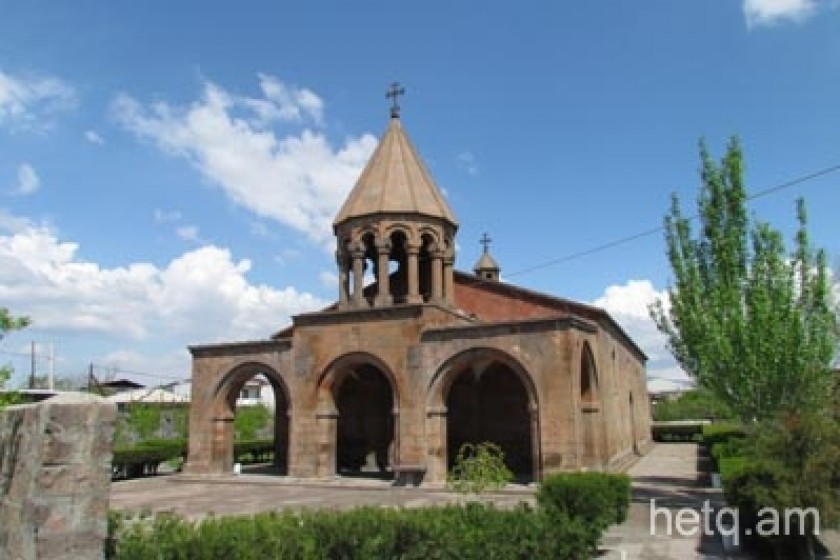
"They've turned St. Gevorg's into a funeral parlor"
Residents of Noragavit, a Yerevan district, are complaining that their local church is slowly turning into a veritable assembly line for religious funerals. Locals claim that services for the repose of souls (hogehangist in Armenian) are being conducting two and even three times a week at the St. Gevorg Church, even on days when regular congregants are expected to visit. It just happened this past Palms Sunday, for example. Last year, pupils who visited the church on the closing day on school, were shocked to see a funeral casket with the deceased inside when they visited to say prayers. Noragavit resident Sergey Hovhannisyan, who says that his ancestors helped build the church, laments the current situation and says he happened upon the funeral ritual on Palms Sunday. "I entered the church to place flowers at my favourite spot and noticed a black curtain had been strung up. Thinking this was the place for flowers I slowly approached and was startled out of my wits when a guy walked out and demanded to know what I was doing. I slowly backed off." Sergey believes that many rich and powerful families use the church to bury their dead out of the spotlight and that the parish priest, Father Mkrtich Tovmasyan, is paid $1,000-2000 for each service he performs. Residents say that they are not opposed to hogehangist services inside the church but that a separate chapel should be built on the church grounds where the entire funeral service can be performed. They even sent petitions signed by 800 residents to Etchmiadzin on two separate occasions. Father Vahram Melikyan, Director of the Mother See’s Public Affairs Department, told Hetq that the petitions had been answered but couldn’t say if they ever reached Noragavit. When I approached Father Mkrtich for his side of the story he asked me for the name of the resident who had sent me and then politely advised me to drop the story. "I would suggest that you not get involved for the matter has been reviewed by the president, prime minister and the Catholicos. This is the law of the church. We return to our roots in the end. The church is just not about happiness. The church is also for the deceased." Seeing that I was going ahead with the article, Father Mkrtich decided to exert some psychological pressure by saying that I would be sinning against the church and that to have any dealings with a clergyman or the church I needed to be above reproach. He then went on to note that many top officials, including the president and prime minister had attended funeral services at the church for the brother of former Minister of Justice Gevorg Danielyan. Father Mkrtich also stressed that the Catholicos was aware of what was going on and that the word from Etchmiadzin was law. "Even the ruling government coalition is informed and what they say is congratulations for getting back to our roots," Father Mkrtich told me. The priest believes that the protestors have nothing better to do and that most don’t even know where the doors to the church are. He even hinted that some might be mixed up in religious cults. Father Mkrtich says that it would be great if a nearby medieval chapel gets restored for the services but that it would cost $500,000. Sergey Hovhannisyan thinks the priest isn’t being sincere and that the church is pretty well endowed right now. "They don’t want to restore the chapel because donations from the rich would dry up. It’s a business they’re running here, not a church," Sergey says. When I asked Father Mkrtich what fees he charges for the repose service, he answered that it was up to the family. He preferred not to respond when I inquired what the biggest "contribution" he ever received was. "Let’s not talk about amounts. No one is interested," he said. Noragavit resident Nina Azizyan says an atmosphere of fear reigns in the church and that people are scared off by the site of the deceased. "We want to pray inside the church but can’t because of the bodies. What is the priest up to by bringing bodies inside? Is it a convenient way to make money?" she asks. Volodya Sedrakyan is another local who hasn’t gone to the church in quite awhile or else attends services at a neigh boring church. The reason is the same. "There’s a body inside the church almost every day," he says, adding that it turns people off. Razmik Aslanyan, who lives near the church, also disagrees with what is going on and prefers not to attend St. Gevorg. "They’ve turned the place into a funeral parlour. I’ve started to lose respect for our Catholicos. It was a tradition in olden times to place the deceased in the church because back then the church was the only cool structure around. Today, they just do it for the money." Hetq sent off a letter to the Ararat Diocese, conveying the discontent of Noragavit residents. It was Father Mkrtich Tovmasyan who responded. Since parish priest don’t receive wages, he wrote, most of the fees for services like the hogehangist go to cover their living expenses. The tiny amount left over goes to the upkeep of the church and grounds. In his response, Father Mkrtich again counselled for understanding and compassion for the deceased and that even in death they remain part of the church and cannot be shunted. He ruled out the possibility that hogehangist services could ever be performed outside the church, in a separate building. "It would be the same as performing a marriage or baptism in the church courtyard at not inside, before the holy altar."
 Videos
Videos Photos
Photos




Comments (5)
Write a comment